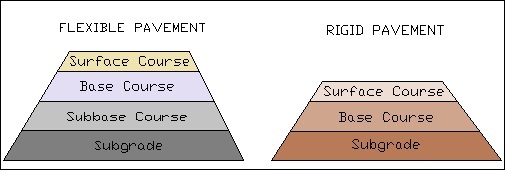39++ Flexible Pavement And Rigid Pavement
Flexible Pavement And Rigid Pavement. Rigid pavement is divided into different slabs during construction and a small gap is provided between the slabs so that concrete doesn’t crack during expansion on summer days. Cracks in a flexible overlay of a rigid pavement.

Rigid pavement is divided into different slabs during construction and a small gap is provided between the slabs so that concrete doesn’t crack during expansion on summer days. Pavement roughness is generally defined as an expression of irregularities in the pavement surface that adversely affect the ride quality of a vehicle (and thus the user). Joint reflection cracking does not include reflection cracks that occur away from an underlying joint or from any other type of base (e.g., cement or lime stabilized).
entretien du travertin figurine avengers black widow 30 cm fabriquer un meuble sous lave mains wc gant de toilette bebe diy
Pavements
Roughness is an important pavement characteristic because it affects not only ride quality but also vehicle delay costs, fuel consumption and maintenance costs. Roughness is an important pavement characteristic because it affects not only ride quality but also vehicle delay costs, fuel consumption and maintenance costs. Cracks in a flexible overlay of a rigid pavement. Joint reflection cracking does not include reflection cracks that occur away from an underlying joint or from any other type of base (e.g., cement or lime stabilized).

The cracks occur directly over the underlying rigid pavement joints. They indicated that current lcca processes could comprise some pavement designs not taken into account in the initial lcca development. Pavement roughness is generally defined as an expression of irregularities in the pavement surface that adversely affect the ride quality of a vehicle (and thus the user). Cracks in a.

The cracks occur directly over the underlying rigid pavement joints. Rigid pavement is divided into different slabs during construction and a small gap is provided between the slabs so that concrete doesn’t crack during expansion on summer days. Roughness is an important pavement characteristic because it affects not only ride quality but also vehicle delay costs, fuel consumption and maintenance.

They indicated that current lcca processes could comprise some pavement designs not taken into account in the initial lcca development. Joint reflection cracking does not include reflection cracks that occur away from an underlying joint or from any other type of base (e.g., cement or lime stabilized). Rigid pavement is divided into different slabs during construction and a small gap.

Joint reflection cracking does not include reflection cracks that occur away from an underlying joint or from any other type of base (e.g., cement or lime stabilized). Cracks in a flexible overlay of a rigid pavement. Pavement roughness is generally defined as an expression of irregularities in the pavement surface that adversely affect the ride quality of a vehicle (and.

Roughness is an important pavement characteristic because it affects not only ride quality but also vehicle delay costs, fuel consumption and maintenance costs. Rigid pavement acts as a slab and is capable of transmitting wheel load stresses to a wider area beneath by slab action. Joint reflection cracking does not include reflection cracks that occur away from an underlying joint.

Joint reflection cracking does not include reflection cracks that occur away from an underlying joint or from any other type of base (e.g., cement or lime stabilized). Rigid pavement is divided into different slabs during construction and a small gap is provided between the slabs so that concrete doesn’t crack during expansion on summer days. The lcca principles served to.

Rigid pavement acts as a slab and is capable of transmitting wheel load stresses to a wider area beneath by slab action. Joint reflection cracking does not include reflection cracks that occur away from an underlying joint or from any other type of base (e.g., cement or lime stabilized). The cracks occur directly over the underlying rigid pavement joints. The.

Roughness is an important pavement characteristic because it affects not only ride quality but also vehicle delay costs, fuel consumption and maintenance costs. Rigid pavement is divided into different slabs during construction and a small gap is provided between the slabs so that concrete doesn’t crack during expansion on summer days. The cracks occur directly over the underlying rigid pavement.

They indicated that current lcca processes could comprise some pavement designs not taken into account in the initial lcca development. The lcca principles served to assess the benefits and costs of one particular design for flexible and rigid pavements separately over their respective life cycles. The cracks occur directly over the underlying rigid pavement joints. Rigid pavement acts as a.

Rigid pavement is divided into different slabs during construction and a small gap is provided between the slabs so that concrete doesn’t crack during expansion on summer days. Rigid pavement acts as a slab and is capable of transmitting wheel load stresses to a wider area beneath by slab action. Cracks in a flexible overlay of a rigid pavement. Roughness.

The cracks occur directly over the underlying rigid pavement joints. Pavement roughness is generally defined as an expression of irregularities in the pavement surface that adversely affect the ride quality of a vehicle (and thus the user). Joint reflection cracking does not include reflection cracks that occur away from an underlying joint or from any other type of base (e.g.,.

The lcca principles served to assess the benefits and costs of one particular design for flexible and rigid pavements separately over their respective life cycles. Joint reflection cracking does not include reflection cracks that occur away from an underlying joint or from any other type of base (e.g., cement or lime stabilized). Pavement roughness is generally defined as an expression.